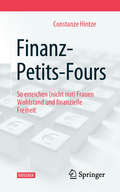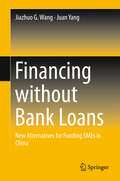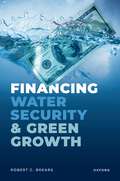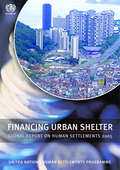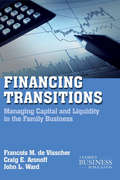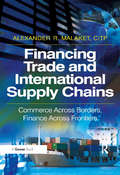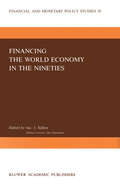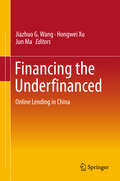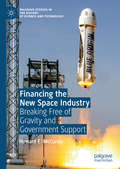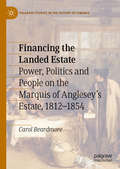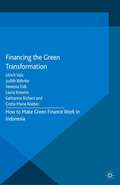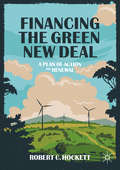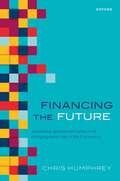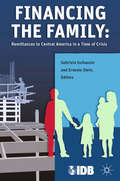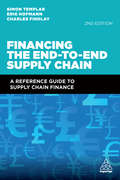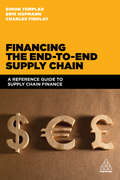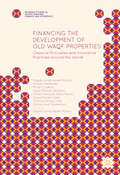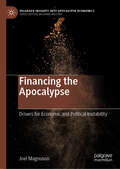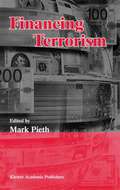- Table View
- List View
Finanz-Petits-Fours: So erreichen (nicht nur) Frauen Wohlstand und finanzielle Freiheit
by Constanze HintzeDie auf ihren Kolumnen aus dem Handelsblatt basierenden Finanz-Petits-Fours von Constanze Hintze bringen Finanzwissen auf den Punkt und bilden insgesamt (nicht nur) für Frauen einen wertvollen Ratgeber für die Vermögensplanung. Das Buch beschäftigt sich mit aktuellen (z. B. „US-Dollar“) sowie generellen Themen und konkreten Finanzprodukten (z. B. „Riestern – ja oder nein“), die Anlegerinnen und Anleger bei Ihrer Vermögensanlage und Altersvorsorge beschäftigen. Es richtet sich an Frauen (und Männer), die ihre finanzielle Zukunft selbst in die Hand nehmen möchten und zeigt ihnen den Weg zu Wohlstand und finanzieller Unabhängigkeit. Das häppchenweise kompakt und verständlich aufbereitete Finanzwissen reichert die Autorin mit zahlreichen Praxisbeispielen und konkreten Empfehlungen an.
Financing without Bank Loans: New Alternatives for Funding SMEs in China
by Jiazhuo G. Wang Juan YangThis book covers all important financial innovations for SME financing, and combines theoretical analysis and real world practices employed in China’s financial market. As China is increasingly becoming a key player in the global economy, the book helps readers gain a better understanding of the current structure and operation of, as well as future changes in, the Chinese economy. Given the high likelihood of RMB joining the IMF’s SDR in the near future, this book offers a well-timed publication that will prove valuable for a broad readership, either as a reference book or as a guide to understanding, researching, teaching on and making business decisions about China and related issues.
Financing Water Security and Green Growth
by Robert C. BrearsFinancing Water Security and Green Growth offers a comprehensive overview of the innovative financial instruments and approaches available to implement water security and green growth initiatives at various scales and in different contexts. Robert C. Brears explores the use of a variety of public, private, and blended finance models to create climate-resilient water supplies, reduce water-energy-food nexus pressures, encourage water conservation and efficiency, and increase water reliability. He examines how these methods can decrease the costs and pollution associated with wastewater disposal, utilize natural processes to improve water quality, manage water quantity by restoring the hydrologic function of the landscape, and improve overall water governance. The book also provides in-depth case studies of the innovative application of financing tools to achieve water security and green growth in various locations of differing climates, lifestyles, and income levels, and identifies best practices.
Financing Water Security and Green Growth
by Robert C. BrearsFinancing Water Security and Green Growth offers a comprehensive overview of the innovative financial instruments and approaches available to implement water security and green growth initiatives at various scales and in different contexts. Robert C. Brears explores the use of a variety of public, private, and blended finance models to create climate-resilient water supplies, reduce water-energy-food nexus pressures, encourage water conservation and efficiency, and increase water reliability. He examines how these methods can decrease the costs and pollution associated with wastewater disposal, utilize natural processes to improve water quality, manage water quantity by restoring the hydrologic function of the landscape, and improve overall water governance. The book also provides in-depth case studies of the innovative application of financing tools to achieve water security and green growth in various locations of differing climates, lifestyles, and income levels, and identifies best practices.
Financing Urban Shelter: Global Report on Human Settlements 2005
by Un-Habitat'Achieving the goals set by world leaders in the United Nations Millennium Declaration will be difficult without a significant improvement in the lives of slum dwellers, and the lives of slum dwellers cannot be improved without the sound and sustainable economic development that is conducive to the establishment of a strong shelter sector. As Financing Urban Shelter: Global Report on Human Settlements 2005 emphasizes, one of the key challenges in meeting the Millennium Declaration Goal on slums is mobilization of the financial resources necessary for both slum upgrading and slum prevention by supplying new housing affordable to lower income groups on a large scale. . . . It is my hope that, by highlighting the impacts of current shelter financing systems on low-income households and by identifying the types of financing mechanisms that appear to have worked for them, this report will contribute to the efforts of the wide range of actors involved in improving the lives of slum dwellers, including governments at the central and local levels, as well as non-governmental and international organizations.' From the Foreword by KOFI ANNAN, Secretary-General, United Nations Financing Urban Shelter presents the first global assessment of housing finance systems, placing shelter and urban development challenges within the overall context of macroeconomic policies. The report describes and analyses housing finance conditions and trends in all regions of the world, including formal housing finance mechanisms, microfinance and community funding, highlighting their relevance to the upgrading of slums. Recent shelter finance policy development is discussed at the international and national levels, and the directions that could be taken to strengthen shelter finance systems are examined. The Global Report on Human Settlements is the most authoritative and up-to-date assessment of conditions and trends in the world's cities. It is an essential tool and reference for researchers, academics, public authorities and civil society organizations around the world. The preceding issues of the Global Report on Human Settlements have addressed such topics as An Urbanizing World, Cities in a Globalizing World and The Challenge of Slums. Published with UN-HABITAT
Financing Urban Shelter: Global Report on Human Settlements 2005
by Un-Habitat'Achieving the goals set by world leaders in the United Nations Millennium Declaration will be difficult without a significant improvement in the lives of slum dwellers, and the lives of slum dwellers cannot be improved without the sound and sustainable economic development that is conducive to the establishment of a strong shelter sector. As Financing Urban Shelter: Global Report on Human Settlements 2005 emphasizes, one of the key challenges in meeting the Millennium Declaration Goal on slums is mobilization of the financial resources necessary for both slum upgrading and slum prevention by supplying new housing affordable to lower income groups on a large scale. . . . It is my hope that, by highlighting the impacts of current shelter financing systems on low-income households and by identifying the types of financing mechanisms that appear to have worked for them, this report will contribute to the efforts of the wide range of actors involved in improving the lives of slum dwellers, including governments at the central and local levels, as well as non-governmental and international organizations.' From the Foreword by KOFI ANNAN, Secretary-General, United Nations Financing Urban Shelter presents the first global assessment of housing finance systems, placing shelter and urban development challenges within the overall context of macroeconomic policies. The report describes and analyses housing finance conditions and trends in all regions of the world, including formal housing finance mechanisms, microfinance and community funding, highlighting their relevance to the upgrading of slums. Recent shelter finance policy development is discussed at the international and national levels, and the directions that could be taken to strengthen shelter finance systems are examined. The Global Report on Human Settlements is the most authoritative and up-to-date assessment of conditions and trends in the world's cities. It is an essential tool and reference for researchers, academics, public authorities and civil society organizations around the world. The preceding issues of the Global Report on Human Settlements have addressed such topics as An Urbanizing World, Cities in a Globalizing World and The Challenge of Slums. Published with UN-HABITAT
Financing Transitions: Managing Capital and Liquidity in the Family Business (A Family Business Publication)
by François M. de Visscher Craig Aronoff John L. WardThis book establishes the principles and patterns necessary to laying the foundation for capital and liquidity planning. Through an in-depth examination of financial situations, it leads family businesses to making wise, well-timed choices about the future of the business and the family.
Financing Trade and International Supply Chains: Commerce Across Borders, Finance Across Frontiers
by Alexander R. MalaketThe vast majority of international trade is supported by some form of trade financing: a specialized, sometimes complex form of financing that is poorly understood even by bankers and seasoned finance and treasury experts. Financing Trade and International Supply Chains takes the mystery out of trade and supply chain finance, providing a practical, straightforward overview of a discipline that is fundamental to the successful conduct of trade: trade that contributes to the creation of economic value, poverty reduction and international development, while increasing prosperity across the globe. The book suggests that every trade or supply chain finance solution, no matter how elaborate, addresses some combination of four elements: facilitation of secure and timely payment, effective mitigation of risk, provision of financing and liquidity, and facilitation of transactional and financial information flow. The book includes observations on the effective use of traditional mechanisms such as Documentary Letters of Credit, as well as an overview of emerging supply chain finance solutions and programs, critical to the financing of strategic suppliers and other members of complex supply chain ecosystems. The important role of export credit agencies and international financial institutions is explored, and innovations such as the Bank Payment Obligation are addressed in detail. Financing Trade and International Supply Chains is a valuable resource for practitioners, business executives, entrepreneurs and others involved in international commerce and trade. This book balances concept with practical insight, and can help protect the financial interests of companies pursuing opportunity in international markets.
Financing Trade and International Supply Chains: Commerce Across Borders, Finance Across Frontiers
by Alexander R. MalaketThe vast majority of international trade is supported by some form of trade financing: a specialized, sometimes complex form of financing that is poorly understood even by bankers and seasoned finance and treasury experts. Financing Trade and International Supply Chains takes the mystery out of trade and supply chain finance, providing a practical, straightforward overview of a discipline that is fundamental to the successful conduct of trade: trade that contributes to the creation of economic value, poverty reduction and international development, while increasing prosperity across the globe. The book suggests that every trade or supply chain finance solution, no matter how elaborate, addresses some combination of four elements: facilitation of secure and timely payment, effective mitigation of risk, provision of financing and liquidity, and facilitation of transactional and financial information flow. The book includes observations on the effective use of traditional mechanisms such as Documentary Letters of Credit, as well as an overview of emerging supply chain finance solutions and programs, critical to the financing of strategic suppliers and other members of complex supply chain ecosystems. The important role of export credit agencies and international financial institutions is explored, and innovations such as the Bank Payment Obligation are addressed in detail. Financing Trade and International Supply Chains is a valuable resource for practitioners, business executives, entrepreneurs and others involved in international commerce and trade. This book balances concept with practical insight, and can help protect the financial interests of companies pursuing opportunity in international markets.
Financing the World Economy in the Nineties (Financial and Monetary Policy Studies #18)
by J. J. SijbenThe present volume contains the texts of the papers and criti cal commentary presented at the one-day conference "Financing the world economy in the nineties" at Tilburg University (23 March 1988). This conference was organized by the Post-graduate School of Banking and Finance of "The Tilburg Institute of Advanced Studies" (T .I.A.S.) which is closely associated to Tilburg University. It should be borne in mind that all the chapters were written before March 1988. Although some were revised later, none of the authors has been asked to include develop ments which have occurred since. To achieve a better understanding of the current financial imbalances in the world economy and its consequences and to discuss the alternatives to correct these imbalances, this conference brought to gether outstanding authorities from the academic world, from the inter national supervisors, and from the industrial companies and the banks. After the editor's introduction about the external disequilib ria in the world economy and the burden of economic adjustment, Chapter 1 is the text of the opening address by Dr. Witteveen. He calls atten tion to the central issue, which financing needs that we can see now may persist into the nineties and how can they be met? In this context he mentions the U.S.-current account deficit, the need for stable exchange rates and the international debt problem.
Financing the Underfinanced: Online Lending in China
by Jiazhuo G. Wang Hongwei Xu Jun MaThis book, as a comprehensive, in-depth analysis of one of the fastest-growing industries in China, covers all the most important areas and issues in the country’s online lending industry. It includes, but is not limited to, the history of online lending, the scale of the online lending market, the basic business models in and a risk analysis of online lending, the characteristics of typical online-lending borrowers and investors/lenders, the root causes of bankruptcy among failed online lending platforms, a comparative analysis of online lending platforms inside and outside China, the overall ranking of online lending platforms in China and finally, the outlook for the online lending industry in the future. The integration of Internet and finance has, in recent years, been among the most notable topics discussed in the media, the business community and academia, both in China and worldwide. The chapters are supplemented with detailed case studies, which include illustrations and tables and the book combines theoretical analysis with conceptual discussions of and best practices in the online lending industry. It will be of interest to a variety of readers worldwide, including: (1) existing and potential online borrowers; (2) existing and potential online lenders; (3) investors and professionals running online lending platforms; (4) traditional bankers and major shareholders in traditional financial institutions; (5) staff in regulatory government agencies; (6) academics; and (7) the general public.
Financing the New Space Industry: Breaking Free of Gravity and Government Support (Palgrave Studies in the History of Science and Technology)
by Howard E. McCurdyThis Palgrave Pivot investigates the efforts of five aerospace companies—SpaceX, Blue Origin, Virgin Galactic, Orbital Sciences, and the Boeing Company—to launch their entry into the field of commercial space transportation. Can private sector firms raise enough capital to end the usual dependence on government funding? What can historical examples of other large-scale transportation initiatives, such as the first transcontinental railway and the first commercial jetliner, teach us about the prospects of commercial space flight? As Howard E. McCurdy shows, commercializing space is a great experiment, the outcome of which will depend on whether new space entrepreneurs can attract support from a variety of traditional and nontraditional sources.
Financing the Landed Estate: Power, Politics and People on the Marquis of Anglesey’s Estate, 1812–1854 (Palgrave Studies in the History of Finance)
by Carol BeardmoreWhile there is an extensive historiography which explores English agriculture in the nineteenth century, there has been less attention paid to individual estates and in particular the role of the land agent within their management, administration and participation in rural community relationships. Nowhere is this more obvious in the lack of research into the financial history of the landed estate, even though in the early nineteenth century these were some of the largest businesses in England. The Castleman letters are a rich source which detail the intricate working, financial, social and political relationships which constituted the foundation of the landed estate. The vouchers of which more than 10,000 have survived alongside the rental accounts have rarely been examined. On their own they illustrate, for example: the sums paid out on maintenance, the interest payments on mortgages, charitable expenditure, spending on property repairs and one-off payments for a wide and diverse range of items. Together with the diurnal correspondence all three aspects of the archive detail the daily financial undertakings and form the foundation of a new financial history of the estate. This book will show that estate management was underpinned by an inherent understanding of the financial decisions which needed to be taken, and will be of interest to academics and researchers of financial history.
Financing the Green Transformation: How to Make Green Finance Work in Indonesia
by Judith Böhnke Vanessa Eidt Laura Knierim Katharina Richert Greta-Maria Roeber U. VolzExplores challenges for developing and emerging economies for enhancing green financing for sustainable, low-carbon investment, looking at Indonesia. Based on surveys in the Indonesian banking and corporate sectors and expert interviews, it devises innovative policy recommendations to develop a framework conducive to fostering green investments.
Financing the Green New Deal: A Plan of Action and Renewal
by Robert C. HockettClimate scientists have determined that we must act now to prevent an irreversible and catastrophic climatic tipping point, beyond which neither our own nor many other species can be assumed likely to survive. On the way to that bleak ending, moreover, extreme socio-economic injustice and associated political breakdown—now well underway in nations already hard-hit by environmental crisis—can be expected to hasten as well. The time has thus come to plan carefully, thoroughly, and on a scale commensurate with the crisis we face. This book, written by one of the key architects of the Green New Deal and prefaced by Representative Alexandria Ocasio-Cortez's former Chief of Staff, indicates how to structure Green New Deal finance in a manner that advances the cross-cutting goals of maximum financial and economic inclusion, maximally democratic decision-making, and an appropriate division of roles both among all levels of government and among public and private sector decision-makers. Integrating into one complete and coherent financial architecture such bold ideas as a 'People's Fed,' an interdepartmental National Investment Council, integrated state and regional public banks, a Democratic Digital Dollar and digital Taxpayer Savings and Transaction Accounts made part of the monetary policy transmission belt, and an economy-wide Price Stabilization Fund, this book is critical reading for policymakers and citizens looking for a fresh path forward towards a revived and sustainable, progressive and productive America.
Financing the Future: Multilateral Development Banks in the Changing World Order of the 21st Century
by Chris HumphreyFinancing the Future explains how the unique governance arrangements and financial model of Multilateral Development Banks (MDB) shape their behavior. Outlining a theoretical framework suitable to the 30-odd MDBs around the world, the book uses this to show how different sets of MDBs are grappling with the challenges of the 21st century. This is the first book to explain the core of the MDB model as a unique class of international institution and shows how that model is playing out the traditional large MDBs, smaller borrower-led banks, and the two new MDBs recently created with the support of China. The combination of an original theoretical approach, rich quantitative and qualitative empirics, and clear writing means this book will appeal to both academic and practitioner audiences.
Financing the Future: Multilateral Development Banks in the Changing World Order of the 21st Century
by Chris HumphreyFinancing the Future explains how the unique governance arrangements and financial model of Multilateral Development Banks (MDB) shape their behavior. Outlining a theoretical framework suitable to the 30-odd MDBs around the world, the book uses this to show how different sets of MDBs are grappling with the challenges of the 21st century. This is the first book to explain the core of the MDB model as a unique class of international institution and shows how that model is playing out the traditional large MDBs, smaller borrower-led banks, and the two new MDBs recently created with the support of China. The combination of an original theoretical approach, rich quantitative and qualitative empirics, and clear writing means this book will appeal to both academic and practitioner audiences.
Financing the Family: Remittances to Central America in a Time of Crisis
by Inter-American Development BankInterest in learning how to make the most of the potential developmental benefits of remittance flows has grown worldwide. Financing the Family adds to that body of knowledge with a summary of recent research that emphasizes experimental approaches, focuses on Central America, and analyzes the impact of the recent financial crisis.
Financing the End-to-End Supply Chain: A Reference Guide to Supply Chain Finance
by Charles Findlay Erik Hofmann Simon TemplarFinancing the End-to-End Supply Chain provides readers with a comprehensive understanding of the financial synergies across the supply chain. It demonstrates the importance of the strategic relationship between the physical supply of goods and services and the associated financial flows. The book provides a clear introduction, demonstrating the importance of the strategic relationship between supply chain and financial communities within an organization. This book links together treasury, banking, supply chain, systems, IT, and key stakeholders. Financing the End-to-End Supply Chain will help senior supply chain practitioners to build collaboration, improve relationships and enhance trust between supply chain partners. With its combination of theory and practice it tackles vital issues including physical, information and financial flows, and tailoring supply chain finance to individual organisations' circumstances. Recognizing that supply chain finance means different things in different countries, the authors also consider various initiatives to harmonize and develop cross-border financing as well as including an agenda for national and international policy makers. The new edition features interviews from SCF platform providers on how ecosystems are involved in supply chain finance, additional learning activities for students and new examples on working capital management.
Financing the End-to-end Supply Chain: A Reference Guide to Supply Chain Finance
by Simon Templar Charles Findlay Erik HofmannFinancing the End-to-End Supply Chain provides readers with a real insight into the increasingly important area of supply chain finance. It demonstrates the importance of the strategic relationship between the physical supply of goods and services and the associated financial flows. The book provides a clear introduction, demonstrating the importance of the strategic relationship between supply chain and financial communities within an organization. It contains vital information on how supply chain finance is operationalised and put into place. It is written in a user-friendly style, starting with the purchasing function, and linking together treasury, banking, supply chain, systems, IT, and key stakeholders. Financing the End-to-End Supply Chain will help senior supply chain and procurement practitioners to build collaboration, improve relationships and enhance trust between supply chain partners. With its combination of theory and practice it tackles vital issues including physical, information and financial flows, and tailoring supply chain finance to individual organisations' circumstances. Recognising that supply chain finance means different things in different countries, the authors also consider various initiatives to harmonize and develop cross-border financing from the World Bank and other institutions, as well as including an agenda for national and international policy makers.Financing the End-to-End Supply Chain offers a mix of academic and industrial expertise and is written by three authors who are experts in the field. The book contains ground-breaking research and data from the Cranfield School of Management.
Financing the End-to-end Supply Chain: A Reference Guide to Supply Chain Finance
by Simon Templar Charles Findlay Erik HofmannFinancing the End-to-End Supply Chain provides readers with a real insight into the increasingly important area of supply chain finance. It demonstrates the importance of the strategic relationship between the physical supply of goods and services and the associated financial flows. The book provides a clear introduction, demonstrating the importance of the strategic relationship between supply chain and financial communities within an organization. It contains vital information on how supply chain finance is operationalised and put into place. It is written in a user-friendly style, starting with the purchasing function, and linking together treasury, banking, supply chain, systems, IT, and key stakeholders. Financing the End-to-End Supply Chain will help senior supply chain and procurement practitioners to build collaboration, improve relationships and enhance trust between supply chain partners. With its combination of theory and practice it tackles vital issues including physical, information and financial flows, and tailoring supply chain finance to individual organisations' circumstances. Recognising that supply chain finance means different things in different countries, the authors also consider various initiatives to harmonize and develop cross-border financing from the World Bank and other institutions, as well as including an agenda for national and international policy makers.Financing the End-to-End Supply Chain offers a mix of academic and industrial expertise and is written by three authors who are experts in the field. The book contains ground-breaking research and data from the Cranfield School of Management.
Financing the Development of Old Waqf Properties: Classical Principles and Innovative Practices around the World (Palgrave Studies in Islamic Banking, Finance, and Economics)
by Magda Ismail Mohsin Hisham Dafterdar Murat Cizakca Syed Othman Alhabshi Shaikh Hamzah Razak Seyed Kazem Sadr Thamina Anwar Mohammed ObaidullahThis book presents successful case studies in Muslim and Muslim minority countries that have revolutionized the redevelopment of idle waqf properties into productive land trusts. The revival of this institution over the last two decades shows the growing optimism in galvanizing the socioeconomic role of waqf by adopting its flexible shariah measures. Innovative ways of financing redevelopment allow Muslims to extend these roles to include new beneficiaries. New uses for these properties include providing services to the community, opening jobs for the majority of people, funding small entrepreneurs, educating the masses, providing health care, and sheltering the poor and needy. Countries under study include Sudan, Turkey, Malaysia, Indonesia, Singapore, New Zealand, Kuwait, Oman, Qatar, and Iran. Additionally, the book examines the International Development Bank's role in financing the development old waqf properties in different countries.
Financing the Development of Old Waqf Properties: Classical Principles and Innovative Practices around the World (Palgrave Studies in Islamic Banking, Finance, and Economics)
by Seyed Kazem Sadr Hisham Dafterdar Murat Cizakca Syed Othman Alhabshi Thamina Anwar Mohammed Obaidullah Magda Ismail Mohsin Shaikh Hamzah RazakThis book presents successful case studies in Muslim and Muslim minority countries that have revolutionized the redevelopment of idle waqf properties into productive land trusts. The revival of this institution over the last two decades shows the growing optimism in galvanizing the socioeconomic role of waqf by adopting its flexible shariah measures. Innovative ways of financing redevelopment allow Muslims to extend these roles to include new beneficiaries. New uses for these properties include providing services to the community, opening jobs for the majority of people, funding small entrepreneurs, educating the masses, providing health care, and sheltering the poor and needy. Countries under study include Sudan, Turkey, Malaysia, Indonesia, Singapore, New Zealand, Kuwait, Oman, Qatar, and Iran. Additionally, the book examines the International Development Bank's role in financing the development old waqf properties in different countries.
Financing the Apocalypse: Drivers for Economic and Political Instability (Palgrave Insights into Apocalypse Economics)
by Joel MagnusonAs we tour the 400 year history of capitalism through its various phases of development, financial system instability is always there lurking in the shadows. The historical record attests that the processes of aggregating capital for real investment are inescapably vulnerable to risk, manic speculation, unserviceable debt, and crises; and with each episode of instability, a trail of devastation follows. Economic historians such as Hyman Minsky, Charles Kindleberger and others have studied this history and have exposed certain boom-bust patterns that have a way of stubbornly repeating themselves.This book posits that the large-scale financial crises that the world has experienced over the last 30 years are more or less the latest segments in this narrative, but with some distinct characteristics. In the period spanning the stock market crash of 1987 to the banking crisis of 2008 and its aftermath – the Greenspan Era – there were key institutional and ideological developments rooted in contemporary neoliberalism that have reshaped the historic rise-and-fall patterns to become more severe and widespread. In this important volume, Magnuson suggests the next episode will be a massive financial cyclone that will send us all tumbling toward a perilous future.
Financing Terrorism
by Mark PiethIn declaring the war against terrorism President George W. Bush also declared war on the financing of terrorism. In this book, bankers, regulators and academics pose a variety of questions from their individual perspectives: What can financial institutions realistically contribute to the suppression of terrorist financing? Can individual rights be protected in these circumstances? These questions are analyzed by experts who come up with some thought-provoking answers.
